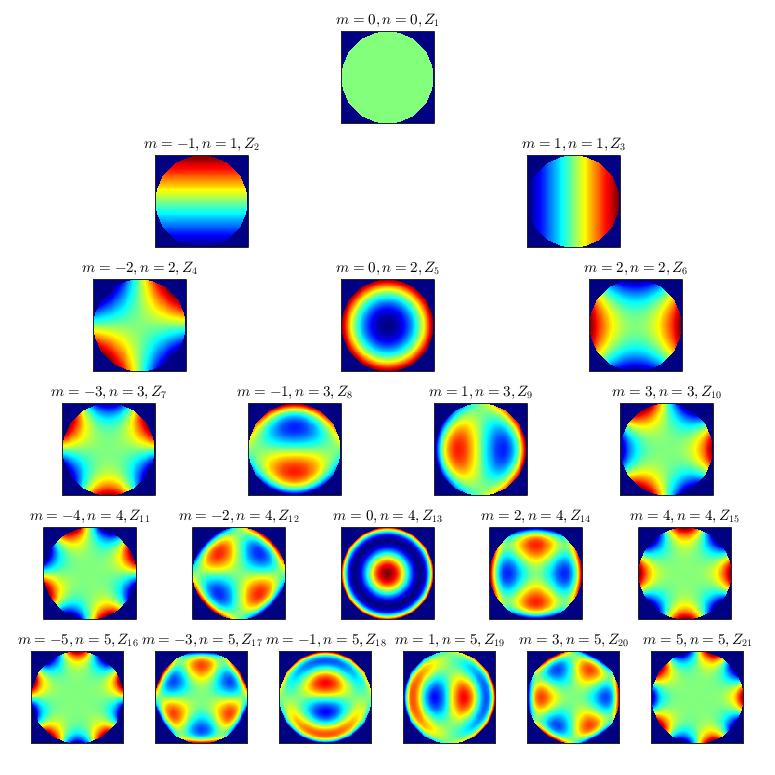结果

代码
clear all;close all;clc;
% Define the range for n and m
n_values = 0:5;
pixels=100;%image x,y pixels
%%The transverse and longitudinal dimensions of the pupil surface
% can enhance the Fourier transform results by reducing the proportion of pupil area
q=300;
% Initialize a figure
fig=figure('name','ZernikePolynomials');
figWidth = 620; % Set the figure width
figHeight = 620; % Set the figure height
set(fig, 'Position', [200, 200, figWidth, figHeight]);
%% Creating mask for unit circle
X = linspace(-1, 1, pixels);
[X, Y] = meshgrid(X, X);
circleMask = (X.^2 + Y.^2) <= 1;
% Loop over n values
for i = 1:length(n_values)
n = n_values(i);
% Loop over m values, incrementing by 2
for m = -n:2:n
% Calculate index for the subplot
subplot_index = (i-1)*(n+1) + (m+n)/2 + 1;
% Calculate radial polynomial
[RmnC,rhoExp] = calcRmn(abs(m),n);
% Calculate zernike polynomial as raster scan
myData = zeros(pixels);
myData = calcZP(RmnC,rhoExp,m,n,pixels);
% Apply mask to myData
myData(~circleMask) = NaN;
% Create subplot
margin=0.04; % Adjust this to control the spacing between subplots
subplot_tight(length(n_values), n+1, subplot_index, margin);
imagesc(myData);
axis square;
colormap("jet");
title(['$m=' num2str(m) ', n=' num2str(n) ', Z_{' num2str(subplot_index-(1+n)*n/2 ) '}$'], 'Interpreter', 'latex');
% Remove x and y labels
set(gca,'xtick',[],'ytick',[]);
end
end
%%
function [PC,PExp]=calcRmn (m,n)
%CALCRMN calculate the radial polynomial
%Inputs Zernike polynomial values m,n
%Returns the coefficients for polynomial exponents
%Parameters
OET=(n-m);%check if odd or even
mC=OET/2;%number of coefficients calculated
%Initialize
RmnC= zeros(1,mC);
rhoExp=zeros(1,mC);
%Calculation of radial polynomial
if mod(OET,2)==0
%do if test is even;otherwise dont
k=0;Rmn=0;
while k<=mC
Rmn=(-1)^k*factorial(n-k)/(factorial(k)*factorial((n+m)/2-k)*factorial((n-m)/2-k));
k=k+1;
PC(k)=Rmn;%Polynomial coefficients
PExp(k)=(n-2*(k-1));%Polynomial exponents
end
end
end%End function
function mD =calcZP(RmnC,rhoExp,m,n,pX)
%CALCZP calculate the zernike polynomial shape
%Inputs radial polynomial,plus m,n,pixels
%Returns the Zernike polynomial data set
%Calculate Zernike polynomial shape
mD=zeros(pX);
for r=1:pX
for c=1:pX
x=(2*c-pX-1)/pX;%convert to x,y
y=(2*r-pX-1)/pX;%convert to x,y
%Calculate quadrant correct angle
phi=atan2(y,x);
%Convert rectangular coord to distance
rho=sqrt(x^2+y^2);
RMN =0;
for count =1:(n-abs(m))/2+1
RMN =RMN+RmnC(count)*rho.^rhoExp(count);
end
%Calculate ZP wavefront
if m<0 || n==0 %select for+/-m
Z=-RMN*sin(abs(m)*phi);
else
Z=RMN*cos(abs(m)*phi);
end
%Control visual appearance
if rho<=1%zero outside unit circle
mD(r,c)=Z;%load value
else
mD(r,c)=0;%change to Nan to hide
end
end
end
end%End Function
参考和拓展阅读
subplot_tight下载
Zernike Polynomial 泽尼克像差多项式 相关资料 - 悦椿一的文章 - 知乎
MathematicaStackExchange - How to plot heatmap function over the unit circle
Wolfram Demonstration - Zernike Polynomials and Optical Aberration
Wolfram Demonstration - Zernike Coefficients for Concentric, Circular, Scaled Pupils
Wolfram Demonstration - Plots of Zernike Polynomials